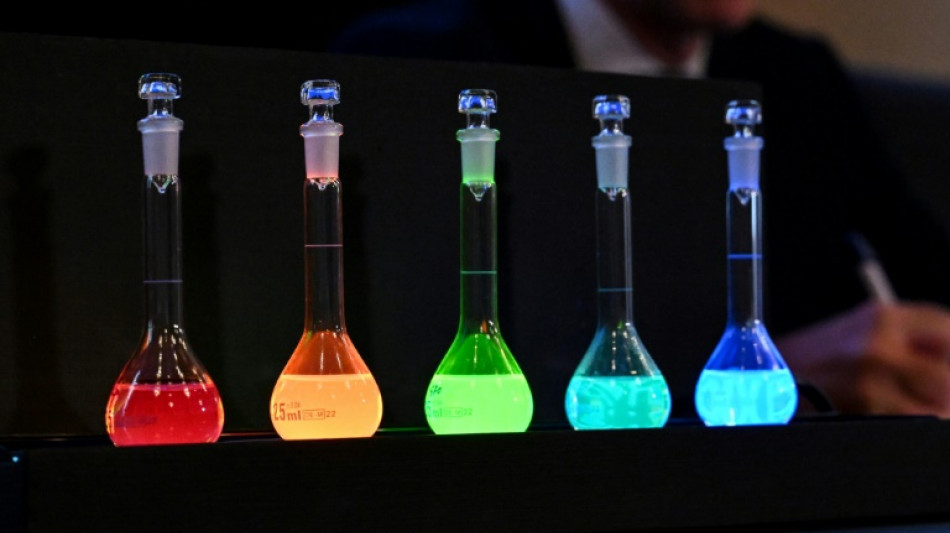
-
 Rain wipes out England's final T20 in West Indies
Rain wipes out England's final T20 in West Indies
-
US speaker opposes calls to release ethics report on Trump's AG pick

-
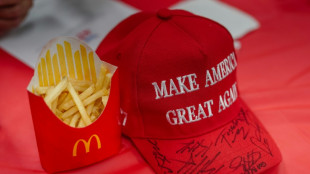 McDonald's feast undercuts Trump health pledge
McDonald's feast undercuts Trump health pledge
-
Thousands march through Athens to mark student uprising

-
 NBA fines Hornets' Ball, T-Wolves' Edwards, Bucks coach Rivers
NBA fines Hornets' Ball, T-Wolves' Edwards, Bucks coach Rivers
-
China's Xi says to 'enhance' ties with Brazil as arrives for G20: state media

-
 Bills snap nine-game Chiefs win streak to spoil perfect NFL start
Bills snap nine-game Chiefs win streak to spoil perfect NFL start
-
Biden answers missile pleas from Ukraine as clock ticks down

-
 Senegal ruling party claims 'large victory' in elections
Senegal ruling party claims 'large victory' in elections
-
Dutch plan 'nice adios' for Nadal at Davis Cup retirement party

-
 Trump meets PGA boss and Saudi PIF head amid deal talks: report
Trump meets PGA boss and Saudi PIF head amid deal talks: report
-
UN chief urges G20 'leadership' on stalled climate talks

-
 Steelers edge Ravens, Lions maul Jaguars
Steelers edge Ravens, Lions maul Jaguars
-
No.1 Korda wins LPGA Annika for seventh title of the season

-
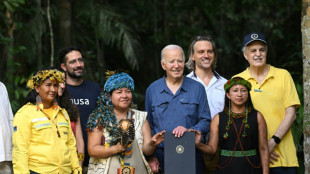 Biden touts climate legacy in landmark Amazon visit
Biden touts climate legacy in landmark Amazon visit
-
England secure Nations League promotion, France beat Italy

-
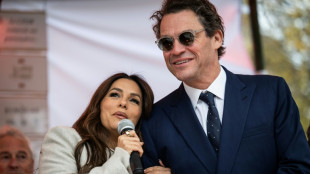 Star power fails to perk up France's premiere wine auction
Star power fails to perk up France's premiere wine auction
-
Rabiot brace fires France past Italy and top of Nations League group

-
 Carsley relieved to sign off with Nations League promotion for England
Carsley relieved to sign off with Nations League promotion for England
-
Sinner says room to improve in 2025 after home ATP Finals triumph

-
 Senegal counts votes as new leaders eye parliamentary win
Senegal counts votes as new leaders eye parliamentary win
-
Biden clears Ukraine for long-range missile strikes inside Russia

-
 Lebanon says second Israeli strike on central Beirut kills two
Lebanon says second Israeli strike on central Beirut kills two
-
Puerto Rico's Campos wins first PGA title at Bermuda

-
 Harwood-Bellis risks wedding wrath from Keane after England goal
Harwood-Bellis risks wedding wrath from Keane after England goal
-
'Nobody can reverse' US progress on clean energy: Biden
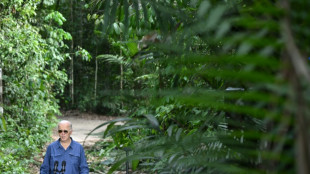
-
 NBA issues fines to Hornets guard Ball, T-Wolves guard Anthony
NBA issues fines to Hornets guard Ball, T-Wolves guard Anthony
-
Biden allows Ukraine to strike Russia with long-range missiles: US official

-
 Britain dump out holders Canada to reach BJK Cup semi-finals
Britain dump out holders Canada to reach BJK Cup semi-finals
-
Biden clears Ukraine for missile strikes inside Russia

-
 Ukrainians brave arduous journeys to Russian-occupied homeland
Ukrainians brave arduous journeys to Russian-occupied homeland
-
Australia not focusing on Grand Slam sweep after thrashing Wales

-
 Wales's rugby woes -- three talking points
Wales's rugby woes -- three talking points
-
Jannik Sinner, the atypical Italian star on top of the tennis world

-
 'Devil is in the details,' EU chief says of S.America trade deal
'Devil is in the details,' EU chief says of S.America trade deal
-
Kusal Mendis defies injury as Sri Lanka beat New Zealand to clinch ODI series

-
 Gatland would back change after Australia condemn Wales to record defeat
Gatland would back change after Australia condemn Wales to record defeat
-
England rout Ireland to earn Nations League promotion in Carsley farewell

-
 England secure Nations League promotion, Haaland inspires Norway
England secure Nations League promotion, Haaland inspires Norway
-
Sinner sweeps past Fritz to win ATP Finals

-
 Massive Russian air attack pounds Ukraine as 1,000th day of war nears
Massive Russian air attack pounds Ukraine as 1,000th day of war nears
-
Mahrez scores as five-goal Algeria crush Liberia

-
 Toll in Tanzania building collapse rises to 13, survivors trapped
Toll in Tanzania building collapse rises to 13, survivors trapped
-
'Red One' tops N.America box office but could end up in the red

-
 NATO's largest artillery exercise underway in Finland
NATO's largest artillery exercise underway in Finland
-
Australia condemn Wales to record 11th successive loss in 52-20 rout

-
 Russian opposition marches against Putin in Berlin
Russian opposition marches against Putin in Berlin
-
Ukraine announces power restrictions after 'massive' Russian attack

-
 Biden begins historic Amazon trip amid Trump climate fears
Biden begins historic Amazon trip amid Trump climate fears
-
Dozens killed, missing in Israeli strike on devastated north Gaza


Quantum dots: the tiny 'rainbow' crystals behind chemistry Nobel
Quantum dots are tiny crystals that scientists can tune to different colours, giving an extra-vivid pop to next-generation TV screens or illuminating tumours inside bodies so surgeons can hunt them down.
Three scientists won the Nobel Chemistry Prize on Wednesday for their work turning an idea first theorised in the 1930s into a reality that now has pride of place in living rooms across the world.
- What are they? -
Quantum dots are semiconducting particles just one thousandth the width of a human hair.
In 1937, the physicist Herbert Froehlich predicted that once particles were small enough -- so-called nanoparticles -- they would come under the strange spell of quantum mechanics.
To explain this quantum phenomenon, American Chemical Society president Judith Giordan said to "think of it like a little box".
When a particle is shrunk down small enough, the electron is "going to whack into the sides of the box," she told AFP.
In a larger box, the electrons would whack the sides less often, meaning they have less energy.
For quantum dots, the larger boxes emit red light, while the smaller ones show up blue.
This means that by controlling the size of the particle, scientists can make their crystals red, blue and everything in between.
Leah Frenette, an expert on quantum dots at Imperial College London, told AFP that working with the nanomaterial was like "watching rainbows all day".
But it would be 40 years after Froehlich's prediction that anyone was able to actually observe this phenomenon.
- Who discovered what? -
In the early 1980s, Russian-born physicist Alexei Ekimov -- one of Wednesday's new laureates -- melted coloured glass and X-rayed the results.
He noticed that the smaller particles were more blue, also recognising that this was a quantum effect.
But being glass, the material was not easy to manipulate -- and being published in a Soviet scientific journal meant few noticed.
At around the same time in the United States, another new laureate Louis Brus -- oblivious of Ekimov's work -- became the first to discover this colourful quantum effect in a liquid solution.
"For a long time, nobody thought you could ever actually make such small particles, yet this year's laureates succeeded," Nobel Committee member Johan Aqvist said.
"However, for quantum dots to become really useful, you needed to be able to make them in solution with exquisite control of their size and surface."
The third new Nobel winner, French-born Moungi Bawendi, found a way to do just this in his lab at the Massachusetts Institute of Technology in 1993.
By precisely controlling the temperature of a liquid mixture of particles called colloid, Bawendi was able to grow nanocrystals to the exact size he wanted, paving the way for mass production.
- What are they used in? -
The most common everyday use of quantum dots is probably in "QLED" televisions.
Cyril Aymonier, head of France's Institute of Condensed Matter Chemistry, told AFP that the nanocrystals "improve the resolution of the screen and preserve the quality of the colour for longer".
Doctors also use their bright fluorescence to highlight organs or tumours in the bodies of patients.
Frenette said she is working on diagnostic tests which would use the dots as "little beacons" for diseases in medical samples.
One problem is that most quantum dots are made using cadmium, a toxic heavy metal.
Both Aymonier and Frenette said they are working on quantum dots that are not toxic.
- Future use? -
In the future, quantum dots could have the potential to double the efficiency of solar cells, Giordan said.
Their strange quantum powers could produce twice as many electrons as existing technology, she explained.
"That's amazing, because we are coming closer to the limit of current solar materials," she added.
- Past use? -
The reds and yellows in stained glass windows as far as back as the 10th century show that artists of the time unwittingly took advantages of techniques that resulted in quantum dots, according to scientists.
W.Nelson--AT




